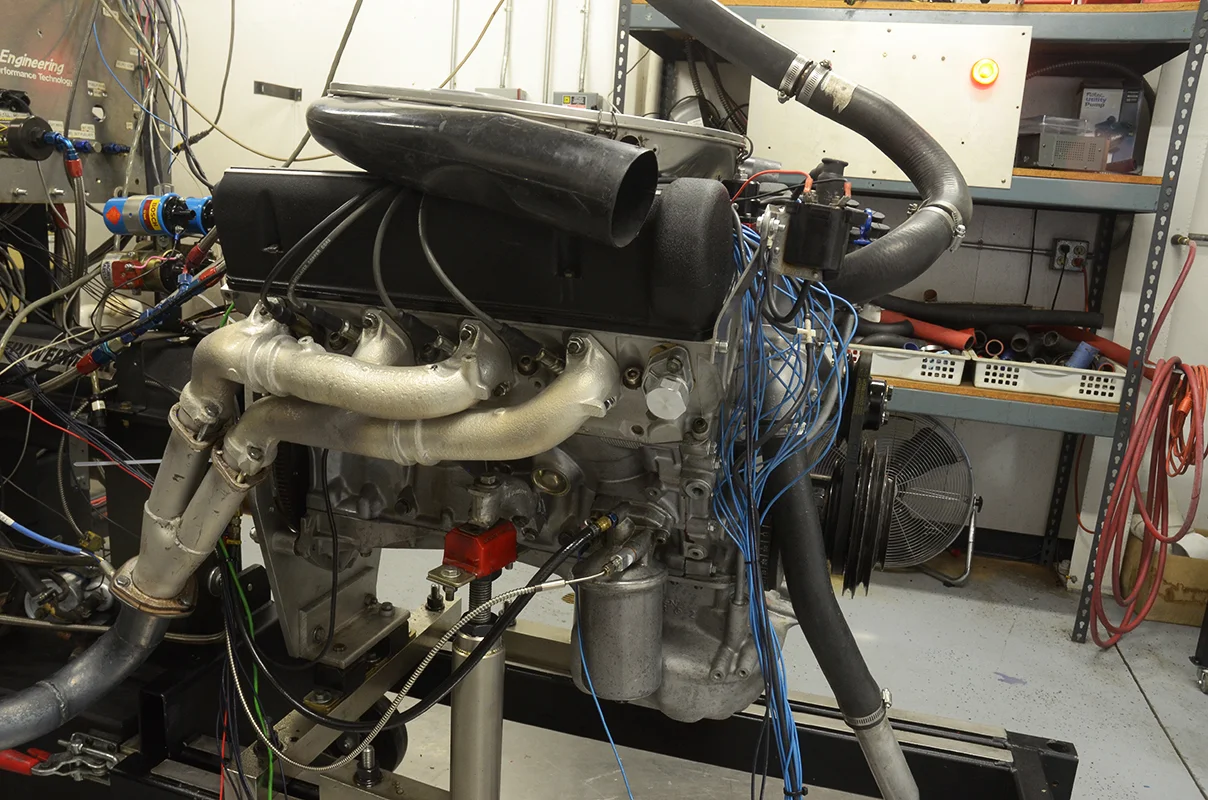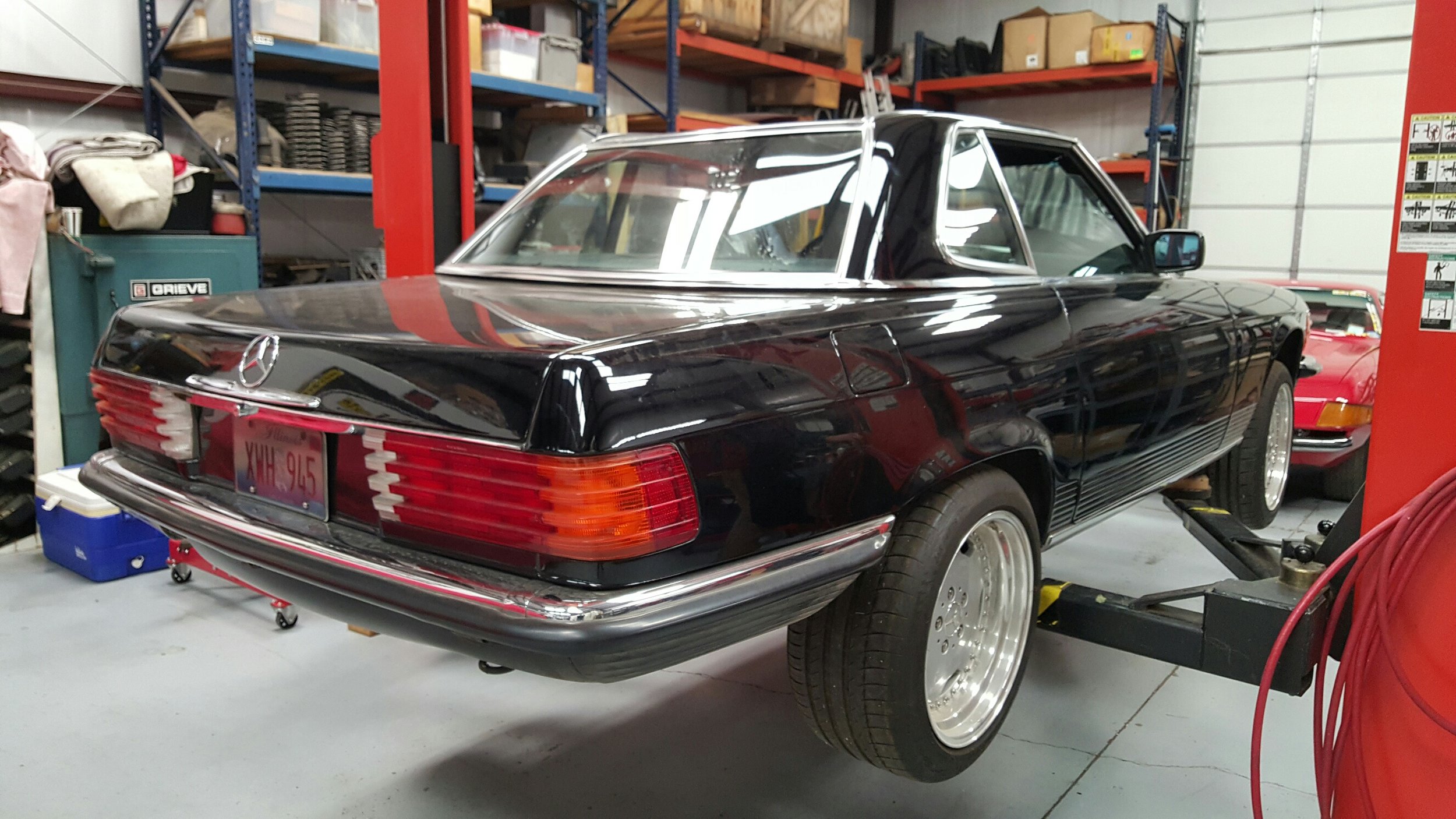1986 Mercedes Benz 560SL
/The starting point of this project was a very nice Mercedes 560SL that had a rebuilt “improved” engine done by a so-called expert Mercedes tuning shop. The owner of the car was not happy with the results, which had a poor idle quality and soggy bottom-end power. The mandate was to improve the power output, calm down the idle and fatten-up the torque curve for additional performance. We agreed that these were all important goals that we could accomplish.
So that there would be a scientific basis for gauging future improvements, the car’s owner approved removing the engine from the car and dyno testing it on our engine dyno in order determine how much power the engine had before we rebuilt it.
While the concept of testing it on the dyno was simple, getting the engine to run on the dyno required a lot of work due to the various electronic/fuel injection systems that all had to operating properly to obtain an accurate power reading. In the end, the existing engine from the alleged Mercedes tuning specialist generated 252-hp at 5,100 rpm and 291 lb-ft of torque at 4,100 rpm. Both these numbers seemed weak to us. The stock V8 560SL engine is rated at 227-hp by the factory so the above initial dyno numbers were not very impressive (see graph below).
We knew that the other shop had installed a more aggressive camshaft, ported the heads to AMG specs and added a full European exhaust system. They claimed over 300 HP but had no dyno graph to back up the claim. It is common knowledge that Mercedes made more powerful versions of the stock 560 engine (not for the USA) that made 300 HP. We didn't understand why this supposedly tuned engine was such a dog.
At this point we received the OK from the owner to tear the engine down and find out what was inside. Much to our surprise, the engine had stock, low-compression pistons (9:1) and one cylinder head that had been ported but the other one was left stock! This was a shocker.
The existing camshaft that was in the engine was put on our camshaft digitizer so that we could determine the specifications. It had the following specs: Intake- 237.2° @ .050” and maximum lift of 10.7 mm. Exhaust- 243.6° @ .050” and maximum lift of 11.15 mm. Compare that to the stock cam specs: Intake/exhaust 192° @ .050” and maximum lift of 10.7 mm. Basically, this performance cam had much more duration, but only a small amount of added lift improvement over stock. Based on past experience with Bosch CIS fuel injection systems, we knew that the idle would not be as stable with this amount of cam duration/overlap, so a new cam would be needed, but the owner wanted to keep this cam set and go to an EFI injection system.
The next step involved flow-testing the cylinder heads. This would be a nice comparison of stock heads versus AMG-ported heads as we conveniently had both types on hand thanks to the previous engine builder. The results proved interesting as there wasn’t much difference between the two! While we were checking out the heads, we were measuring all of the basic engine dimensions so we could start building a relatively accurate model to use for simulation work. Our program is ‘Performance Trends Engine Analyst Pro Enterprise Edition’ and over the years it has proven very helpful to finding power in various engines before actually beginning the engine building process.
One of the areas that we knew could be improved was the intake manifold. The standard runners are pretty convoluted and the plenum volume is small, both of which restrict optimal air flow. Based on our calculations, the throttle body seemed adequate for the power level we needed- which was 350-plus horsepower. We decided to flow test just the runner section of the 2-piece manifold as the lower plenum wouldn’t fit on the flow test rig. The result showed a definite reduction in flow, but not enough to explain the low power.
We decided to flow test just the runner section of the 2-piece manifold as the lower plenum wouldn’t fit on the flow test rig. The result showed a definite reduction in flow, but not enough to explain the low power.
Based on past experience, we knew that the early 450 SL EFI intake manifold had straighter runners. Also, if we used that manifold, then the CIS injection system would have to go and be replaced with EFI.
Testing the two manifolds showed that the straighter runners of the EFI manifold (above) did make a difference.
The test graph shown below displays how much better the EFI runners are at higher flows. We used the Extrude Hone process to increase the EFI runners to 40mm which then matched the original 560 CIS manifold runner size.
In the graph below, the light blue line is the stock cylinder head by itself. The dark blue line is the head with the EFI runners attached and the green line is the head with the standard 560 intake runners.
Another area of the intake manifold that needed help was the plenum area. Although it is out of sight unless you cut it open like we did, the ability of the air to make a tight 180° turn is limited by the low headroom in the plenum. In essence, this is the same as running a restrictor plate on the engine. The stock 560 throttle body flows about 577 cfm by itself, but based on our calculations, the CIS intake manifold cuts that in half!
So, the heads are flowing well, the throttle body is big enough, but there is a huge restriction in the manifold! Who knew? This is why using traditional tuning methods on the single-cam Mercedes V8s has been such a failure if the stock intake was retained. Better flowing heads weren’t the answer or more aggressive cams; the manifold just needed some attention.
The solution lay in modifying the plenum chamber for more depth. This isn’t that easy because the "V" area of the engine between the heads is a tight space. A compromise was made of cutting the runner/plenum junction back a ½-inch and then dropping the roof of the plenum chamber down about the same amount. This would allow extra room for the air to turn back up into the runners without killing the flow.
Modified intake manifold allows air to flow nearly twice as much as stock.
After solving the intake flow problem, the next step was enlarging the engine displacement with high-compression (10.5:1), +2mm oversize Mahle forged racing pistons. Mahle was chosen as they are one of the few piston companies that can add the correct skirt plating for the Alu-Sil block (since this was originally written, other companies have offered Alu=Sil compatible coatings). The +2mm sizing was chosen because that is the limit of the stock head gasket fire-ring.
Because we used new pistons we now needed to use different connecting rods. Mahle only has room on their piston forging for a 22-mm piston pin size. The stock pin is 25-mm. If the difference had been small, say .5-mm, then the original connecting rod small end could have been re-bushed, but 3-mm is too much. Consequently, new Carrillo rods were made with the correct size small ends. Our new HB Sport pistons now can accommodate the stock pin size thus saving some cost by not requiring that Carrillo rods be bought,
The big advantage to the new piston and rod combination was a dramatic weight reduction. By comparison, the OEM parts look like they are from a diesel engine. To compensate for the reduction in weight, the stock crank was rebalanced.
The new Mahle high compression piston on the left, next to the stock and heavier piston on the right. Note the reduction in the skirt area of the new piston.
The stock connecting rod is pictured on top, with the new Carrillo rod on the bottom, which is stronger and lighter.
Once the various parts were designed and custom built, engine builder Bert Wehr assembled the motor.
Once the engine was assembled, attention was turned to adapting various systems and components on it to work with the modern HB Sport EFI (electronic fuel injection) that was being used. Many modifications and a substantial amount of custom engineering and fabrication were necessary to make this work. This included fabricating a new throttle shaft, fuel rails, etc. and of course sourcing the correct injectors, sensors, etc. that allow the engine to run correctly. Many hours were involved with getting the EFI up and running on the dyno.
On initial startup, the 560 SL's reborne V8 sounded like a beast with crisp throttle response.
Video of the 560SL motor on Carobu's dyno
After the appropriate break-in time and some fuel curve mapping, the result was truly eye-opening (see graph above).
With 350 HP and 392 lb-ft of torque this was just what the doctor ordered. The beast had been unleashed at last! This should be a seriously fun Mercedes to drive. Interestingly, the engine simulation tracked fairly well with the dyno results, as you can see in the graph below.
Note: since this article was originally written in 2016, many changes have been made to our Mercedes tuning program. We can now make this level of power with the standard Bosch CIS K-Jet injection system and improved camshaft profiles.















